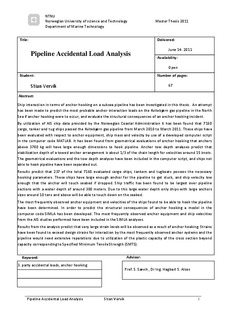| dc.contributor.author | Vervik, Stian | nb_NO |
| dc.date.accessioned | 2014-12-19T12:06:33Z | |
| dc.date.available | 2014-12-19T12:06:33Z | |
| dc.date.created | 2012-02-06 | nb_NO |
| dc.date.issued | 2011 | nb_NO |
| dc.identifier | 490903 | nb_NO |
| dc.identifier.uri | http://hdl.handle.net/11250/237936 | |
| dc.description.abstract | Ship interaction in terms of anchor hooking on a subsea pipeline has been investigated in this thesis. An attempt has been made to predict the most probable anchor interaction loads on the Kvitebjørn gas pipeline in the North Sea if anchor hooking were to occur, and evaluate the structural consequences of an anchor hooking incident.
By utilization of AIS ship data provided by the Norwegian Coastal Administration it has been found that 7160 cargo, tanker and tug ships passed the Kvitebjørn gas pipeline from March 2010 to March 2011. These ships have been evaluated with respect to anchor equipment, ship mass and velocity by use of a developed computer script in the computer code MATLAB. It has been found from geometrical evaluations of anchor hooking that anchors above 3780 kg will have large enough dimensions to hook pipeline. Anchor tow depth analyses predict that stabilization depth of a towed anchor arrangement is about 1/3 of the chain length for velocities around 15 knots. The geometrical evaluations and the tow depth analyses have been included in the computer script, and ships not able to hook pipeline have been separated out.
Results predict that 237 of the total 7160 evaluated cargo ships, tankers and tugboats possess the necessary hooking parameters. These ships have large enough anchor for the pipeline to get stuck, and ship velocity low enough that the anchor will touch seabed if dropped. Ship traffic has been found to be largest over pipeline sections with a water depth of around 300 meters. Due to this large water depth only ships with large anchors sizes around 10 tons and above will be able to touch down on the seabed.
The most frequently observed anchor equipment and velocities of the ships found to be able to hook the pipeline have been determined. In order to predict the structural consequences of anchor hooking a model in the computer code SIMLA has been developed. The most frequently observed anchor equipment and ship velocities from the AIS studies performed have been included in the SIMLA analyses.
Results from the analysis predict that very large strain levels will be observed as a result of anchor hooking. Strains have been found to exceed design strains for interaction by the most frequently observed anchor systems and the pipeline would need extensive reparations due to utilization of the plastic capacity of the cross section beyond capacity corresponding to Specified Minimum Tensile Strength (SMTS). | nb_NO |
| dc.language | eng | nb_NO |
| dc.publisher | Norges teknisk-naturvitenskapelige universitet, Fakultet for ingeniørvitenskap og teknologi, Institutt for marin teknikk | nb_NO |
| dc.title | Pipeline Accidental Load Analysis | nb_NO |
| dc.type | Master thesis | nb_NO |
| dc.contributor.department | Norges teknisk-naturvitenskapelige universitet, Fakultet for ingeniørvitenskap og teknologi, Institutt for marin teknikk | nb_NO |
